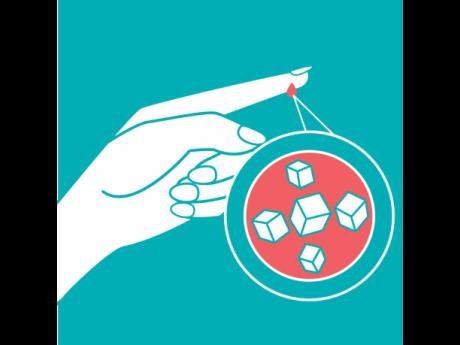Errol Morrison and Andrew Wheatley | Culture, COVID-19 and diabetes
Healthy eating is a cornerstone of healthy living. In the presence of diabetes, you need to know how foods affect your blood sugar(glucose) levels. It is not only the type of foods or the combinations thereof that you eat, but also how much and when you eat. Understanding how food affects your blood sugar level requires knowledge of its total glucose content as well as how quickly the glucose is absorbed into the blood stream (glycaemic index), and this is critical to the proper management of diabetes. It is best to avoid food that causes quick spikes in blood glucose levels when consumed such as sugary foods and drink, white bread, Irish potatoes, and white rice. These are said to have a high glycaemic index. Typically, low to medium glycaemic index foods include vegetables, most fruits, oat bran, bananas, and whole wheat bread. Further, in the diabetes state, it is best to avoid large food intake and to spread out meals into smaller quantities more often so as to allow the body to handle the glucose load more evenly and reduce the tendency for spikes in the blood sugar levels.
Approximately 270,000 Jamaicans are Type 2 diabetics, with another 30,000 living with Type 1. Type 2 diabetes is where the body has adequate quantities of the hormone insulin, which manages blood sugar, but it fails to function properly and keep the blood sugar levels within the desired limits. Type 1 is where there is little or no insulin and measures have to be taken to replace it.
Diabetes results in a generalised failure of the functioning of the organs in the body. Thus, it also prevents the body from adequately responding to external attacks such as infections and is generally a major risk factor for the development of severe complications such as pneumonia and sepsis during viral infections such as COVID-19.
The imposed social distancing and lockdowns to curb the spread of the COVID-19 virus by many Governments have resulted in challenges in both institutional and self-management of diabetes. Many people the world over, have difficulties accessing medications, healthcare, fresh food, clean water, and are also physically inactive, especially in this period of confinement during the pandemic.
According to the International Diabetes Federation, older people and people with pre-existing medical conditions (such as diabetes, heart disease, and asthma) appear to be more vulnerable to becoming severely ill with the COVID-19 virus. In fact, data now show that 20 pre cent of persons hospitalised as a result of COVID-19 have diabetes, and a little more than 26 per cent of persons who died from COVID-19 had diabetes.
When persons with diabetes develop viral infections, even if there are no obvious symptoms, the diabetes proves more difficult to treat, and fluctuations in blood sugar levels occur, and the associated diabetes complications worsen. There appears to be two main reasons for this. The compromised immune system makes it more difficult to fight the virus, leading to a longer recovery period, and the virus may thrive in an environment disturbed by elevated blood sugar levels wherein there is an accumulation of oxidising molecules, attacking acids and a milieu of damaging products.
CULTURE AND THESE TWO MALADIES
You may say that COVID-19 is an infection, so what does culture have to do with it? Well, the very fact that it is an airborne disease and transmissible from person to person indicates that we are very prone because we habitually “talk up” into each other’s face. We shout to emphasise a point, especially when excited about activities such as sporting events, or when there are disagreements.
We laugh heartily, loudly, and openly in large or small crowds.
We cough upwards into the air, spit on sidewalks, and yawn unceasingly in uninteresting settings.
We enjoy a tight hug and a kiss on the cheek.
We do all the above without thinking and so spread viral particles all around.
With that kind of proclivity, it is no wonder that we find wearing masks uncomfortable and challenging, and even when we make an effort so to do, at the oh so frequent moment, the mask is slipped off as we indulge in our cultural mores.
COVID-19 is not going away anytime soon. Neither will our cultural norms change sometime soon. Herein lies the challenge as we try to beat this pandemic into submission.
Pause for a moment and look at the non communicable chronic diseases (NCDs) as typified by diabetes. Over the decades, we have been using evidence-based medicines and best practice behavioural guidelines in attempting to control this malady, yet its prevalence continues to rise and policymakers are envisaging its costs to the public purse escalating to billions. As we indicated earlier, it also is a leading cause of suffering and death among our people.
It is a growing, serious, costly, public health burden! We are losing the battle and why so?
Let us look at the fundamental teachings and advice being meted out to diabetes sufferers.
Eat small amounts frequently and avoid starches before going to bed. The culture is to eat a bellyful whenever it is available and that evening meal called dinner provides such an opportunity. As the saying goes “Before good food spoil, mek belly buss”. We all grew up under that influence, and it is most acceptable to look big and hearty and we proudly maintain “we come from big breed!” (less than five per cent of overweight persons inherit the tendency. The overeating culture creates fat parents who, in turn, beget fat children). To lose weight elicits the comment “How yuh draw down so?” and carries suspicion of some catching disease.
Hence our culture encourages overweight, which is indeed a major aggravator of diabetes.
One thing in our favour is that especially in rural communities, we walk long distances, not so much that we want to, but rather that the public transport system is so inadequate.
MEDICAL INTERVENTIONS
Now, come to the medical intervention and the prescribing of drugs. As far back as the 1950s, we have chronicled the use of herbs and bush teas in the treatment of the non-communicable chronic diseases (NCDs). Periwinkle (ramgoat roses) was among the most commonly used in diabetes, and while it didn’t go on to become a mainstay, it is now widely grown in Madagascar for providing drugs (vinca alkaloids) used in certain blood cancers. The idea for testing it originated here in the parish of St Elizabeth, but Jamaica has not been acknowledged for that innovation.
Over the decades, many other preparations have been used, extracts from annatto, bird pepper, guinea hen weed, comfrey, noni, moringa, cerassee, and the list goes on.
In the 1970s, Alleyne, Morrison et al, in reviewing factors that influenced the management of diabetes, found that some 70 per cent of patients attending the diabetes clinic at the University Hospital of the West Indies (UHWI) were using alternative medicines consisting of a variety of the herbs and bushes. Further, irrespective of their socioeconomic status, the clinic doctor was the second stop in consultation as again, most of them had had previous consultations with the “village doctor or obeah man” who would cast out spells, apply various baths and potions, and administer healing drinks. A Harvard study in the latter 1990s revealed that some 90 per cent of patients did not tell their doctor that they were using complementary alternative medicines for their healthcare.
The village practitioners are also functioning in the approach to the COVID-19 infection as they chant out spirits and hand out potions to keep away and cure the virus attack. Dangerous - but that’s an integral and deep-rooted aspect of our culture. It has to be interdicted. We must strategise how best to intercede in these cultural practices that evoke adverse outcomes for our public health.
This is endemic, and we ignore these practices at the expense of failing to understand potential interactions of drugs and bush teas as well as being unable to interdict behavioural preferences where individuals adhere to the peer advice and practices so significantly influenced and directed by the village practitioners.
Thus, the average doctor trained in allopathic medicine ‘misses the bus’, prescribes in vain, and the management is compromised, often leading to less than optimal outcomes.
Recognition of the need to acknowledge and accommodate these indigenous practices was embraced by the World Health Organization (WHO) in the 1960s, and the Alma Ata Declaration (1978) recommended that the Western-trained allopathic practitioners work side by side with the local indigenous ones and try to gain wider acceptance by the attending public. Behold, that experiment failed to take root and was mostly abandoned.
Today, we continue to bury our heads in the sand, and now, the NCDs have burgeoned and are the leading causes of death worldwide, and diabetes is in the forefront.
TOGETHER THEY FALL
Now the world is gripped by the double whammy of COVID-19 and diabetes. The pharmaceuticals are proffering vaccines and drugs, the nutraceuticals are offering teas/extracts, and other complementary alternative practitioners have many bags of tricks purporting to be a cure for one or the other malady. And although we mouth best practices such as wear a mask, keep your distance, wash hands and sanitise frequently for COVID-19 prevention; and eat less and walk more for diabetes containment – no one is talking to the “village doctor”, who exercises a great influence over our knowledge, beliefs, and practices.
The common culprit is our culture, and that requires immediate in-depth study and understanding to bring these harbingers of death under control.
Prof Errol Morrison is an endocrinologist and biochemist and president of the Diabetes Association of Jamaica; Dr Andrew Wheatley is senior lecturer/research scientist in basic medical sciences and member of Parliament St Catherine South Central.




